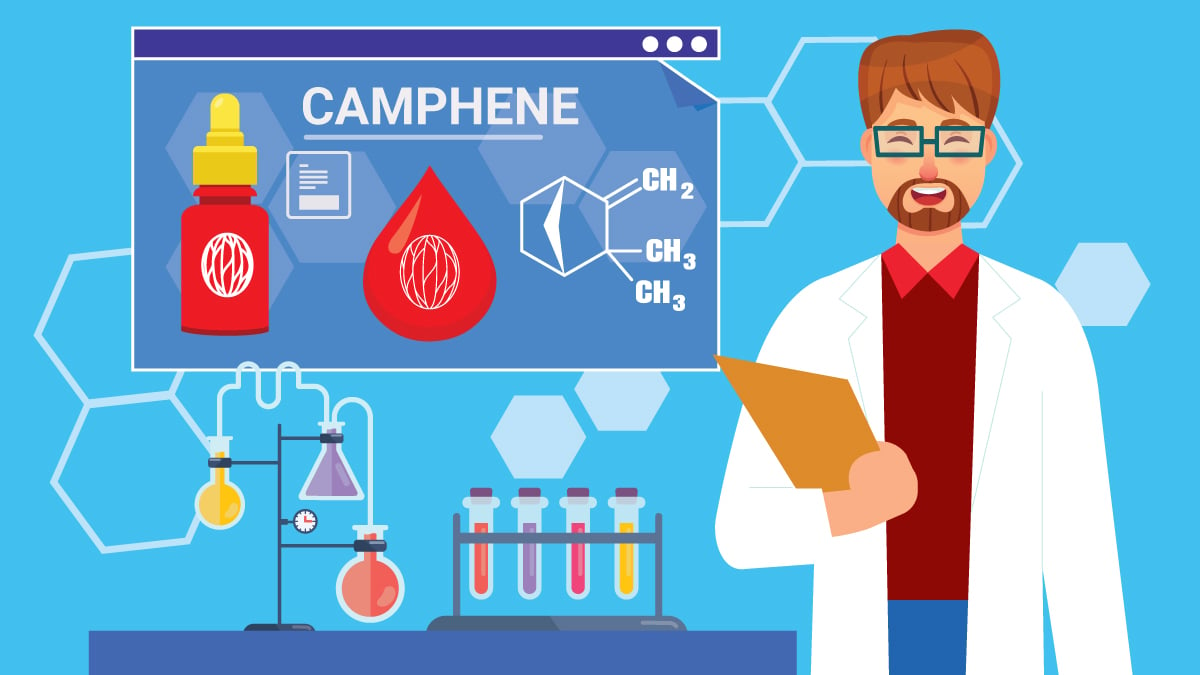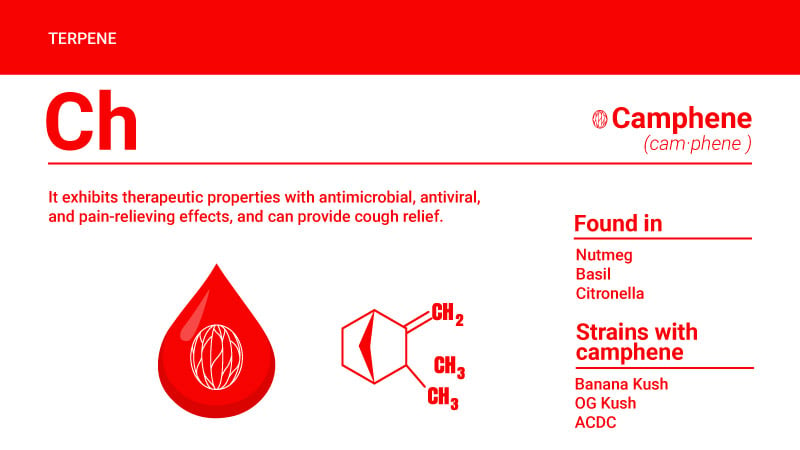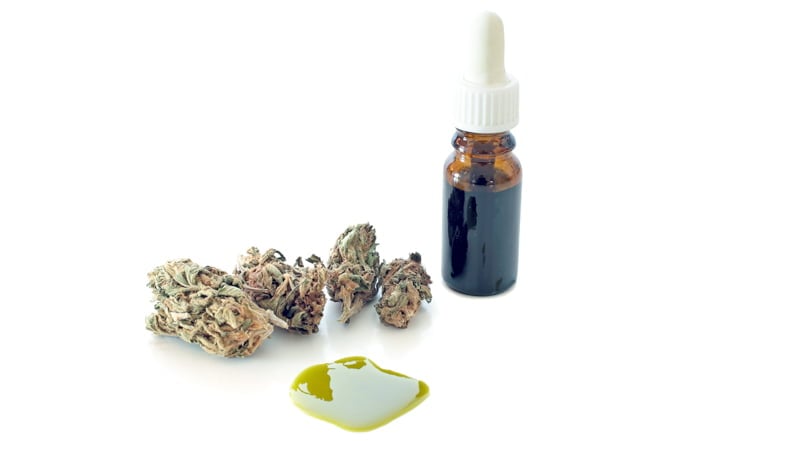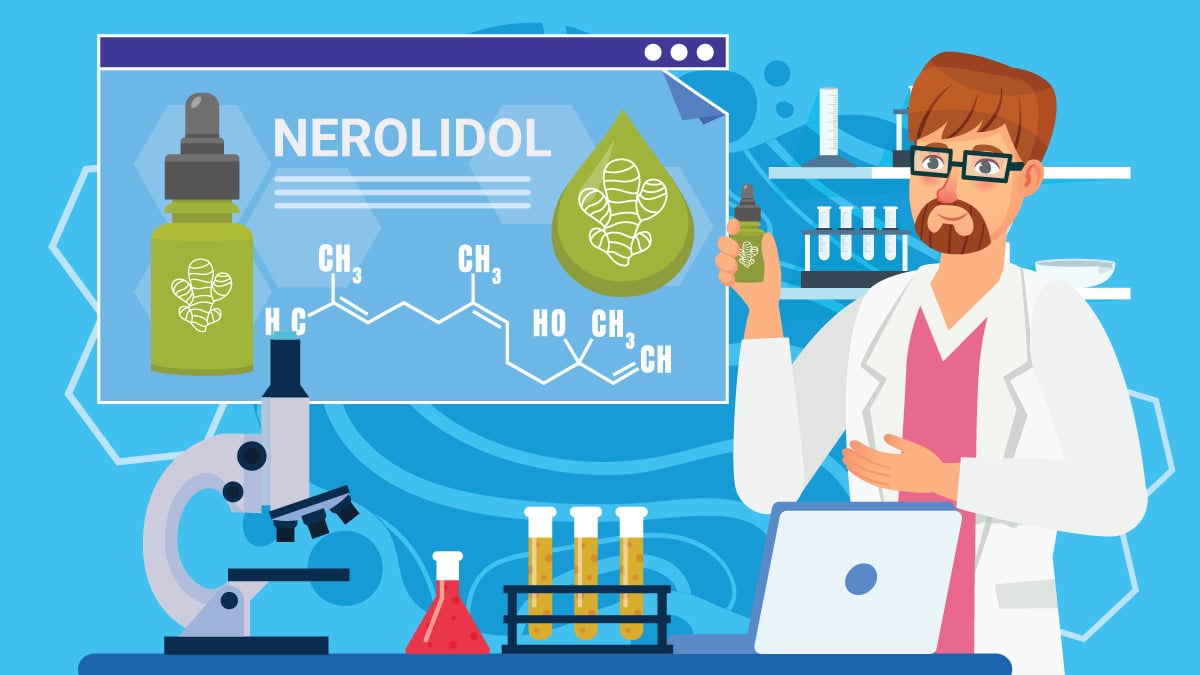Camphene Terpene: Benefits, Effects, Dosage, & More

Camphene is a simple terpene — consisting of two isoprene units. Simple as it may be, camphene is a powerhouse — offering a distinct and pungent aroma and powerful health benefits.
While research is still in its infancy, every year new studies are published highlighting new uses of this unique molecule.
What is camphene, what are its benefits, and what cannabis strains are highest in this terpene? Here’s everything you need to know about camphene.
What Is Camphene?
Camphene is a monoterpene found in camphor, pine, fir, cannabis, cypress, spruce, citronella, neroli, ginger, rosemary, cistus, sage, valerian, and more.
Monoterpenes are highly volatile and prone to oxidation, insoluble in water, and more common than you might think.
Summer wouldn’t be the same without the pungent smell of citronella candles. The familiar smell is both comforting and slightly unpleasant — comforting because it means no mosquitoes.
This colorless crystal is an effective substitute for camphor and is in many cannabis cultivars, perfumes, essential oils, and foods because of its waxy, musky, earthy, and slightly woody scent. It also adds texture to lacquers and resins.
Back in the 19th century, camphene was used for fuel in lamps as it was a more affordable choice than whale oil. It isn’t typically used as a lamp fuel anymore, as kerosene is much cheaper and burns much brighter.
What Does Camphene Smell Like?
Camphene gives off a pungent, strong aroma reminiscent of wet pine needles on a forest floor. The musky undertones give off a “wet-earth” kind of smell. The woodsy notes are unmistakable, as well as some more refreshing hints of pine or fir.
Plants That Contain Camphene
Camphene can be found in lots of different things. It’s one of the more common terpenes in the plant kingdom.
List of plants that contain camphene:
- Cannabis
- Camphor
- Pine
- Fir
- Cypress
- Spruce
- Citronella
- Neroli
- Ginger
- Rosemary
- Sage
- Citrus
- Nutmeg
- Valerian
How Common Is Camphene In Cannabis?
Camphene is relatively common in cannabis — but rarely the most abundant terpene. Most marijuana or hemp strains contain camphene in concentrations below 0.2%, but there are some exceptions.
The strains that contain the highest concentrations of camphene are those with a distinct woody aroma, contain high levels of THC, and are loosely related to kush genetics. This terpene is usually found in higher potency strains, featuring a THC level of 15-20%.
It also appears to be more common in hybrid strains, although there are instances where you can find camphene-rich indica or sativa strains too.
List of Cannabis Strains That Contain Camphene
- White Widow
- Strawberry Kush
- White Cookies
- Sweet Tooth
- Wonka Bars
- Pink Kush
- Bruce Banner
- NYC Diesel
- Banana Kush
Chemical Structure of Camphene
Camphene is a colorless, crystalline monoterpene that is insoluble in water. It occurs in turpentine and various other essential oils.
As a monoterpene, camphene is closely related to other terpenes, such as pinene, borneol, citral, delta-3-carene, eucalyptol, geraniol, isopulegol, geranyl-acetate, isopulegol, limonene, linalool, myrcene, ocimene, phellandrene, and many others.
Camphene Specs:
- IUPAC Name: 2,2-dimethyl-3-methylidenebicyclo[2.2.1]heptane
- Type of Terpene: Monoterpenoid
- Molecular Formula: C10H16
- Molecular Weight: 310ºF
- Solubility: Soluble in water
Does Camphene Get You High?
No, camphene will not get you high.
There are very few terpenes with psychoactive effects (see myristicin and salvinorin A).
While camphene is in a variety of cannabis cultivars, it’s not the compound that creates the intoxicating high that people are familiar with; delta-9 is what causes the “high.”
Is Camphene Safe To Use?
Camphene is generally safe when it comes to using it as an additive in products, either perfumes or food enhancing flavorings — though some hazardous qualities of camphene require a warning.
First of all, it’s flammable. Secondly, it can be irritating to the eyes, lungs, and skin if used excessively.
As with all terpenes, you’ll want to wear gloves and goggles when working with it in its pure form. Always aim to dilute camphene to 5% or less of the total volume of product you’re working with.
Ultra-high concentrations of any terpene can cause irritation to the skin, eyes, or lungs.
Learn More: Are Terpenes Safe To Consume?
How To Use Camphene?
You can find camphene in various products, many of them are in our everyday lives.
Perfume is a common addition for women worldwide, and if your perfume gives off some woody, earthy tones, camphene may just be at play. It can also be in food flavorings, so you may be ingesting camphene without knowing it.
Besides products that contain camphene that you have probably already used or tasted, you can also find camphene in tincture bottles (used to combine with CBD oil or some other carrier oil) or aromatherapy products.
Learn More: How to use Terpenes
Key Takeaways: What Makes Camphene Special?
Camphene is unique because of the wide spectrum of benefits it provides and the unique aromatic profile it contributes. This terpene has many benefits, but most of its effects are considered “relaxing” or “calming.”
This woodsy terpene is truly a gem in the world of terpenes and can be a valuable tool when implemented correctly.
References Cited
- Tiwari, M., & Kakkar, P. (2009). Plant-derived antioxidants–geraniol and camphene protect rat alveolar macrophages against t-BHP induced oxidative stress. Toxicology in vitro, 23(2), 295-301.
- Polatoglu, K., Demirci, F., Demirci, B., Gören, N., & Başer, K. H. (2010). Antibacterial activity and the variation of Tanacetum parthenium (L.) Schultz Bip. Essential oils from Turkey. Journal of oleo science, 59(4), 177–184. https://doi.org/10.5650/jos.59.177
- Sampietro, D. A., Gomez, A. D. L. A., Jimenez, C. M., Lizarraga, E. F., Ibatayev, Z. A., Suleimen, Y. M., & Catalán, C. A. (2017). Chemical composition and antifungal activity of essential oils from medicinal plants of Kazakhstan. Natural product research, 31(12), 1464-1467. [3]
- Baek, S., Kim, J., Moon, B. S., Park, S. M., Jung, D. E., Kang, S. Y., … & Lee, K. P. (2020). Camphene Attenuates Skeletal Muscle Atrophy by Regulating Oxidative Stress and Lipid Metabolism in Rats. Nutrients, 12(12), 3731.Schäfer D, Schäfer W., 1981;31(1):82-6.
- Schäfer, D., & Schäfer, W. (1981). Pharmacological studies with an ointment containing menthol, camphene and essential oils for broncholytic and secretolytic effects. Arzneimittel-forschung, 31(1), 82-86.
- Vallianou, I., Peroulis, N., Pantazis, P., & Hadzopoulou-Cladaras, M. (2011). Camphene, a plant-derived monoterpene, reduces plasma cholesterol and triglycerides in hyperlipidemic rats independently of HMG-CoA reductase activity. PloS one, 6(11), e20516.
- Lima, D. K., Ballico, L. J., Lapa, F. R., Gonçalves, H. P., de Souza, L. M., Iacomini, M., … & Santos, A. R. S. (2012). Evaluation of the antinociceptive, anti-inflammatory, and gastric antiulcer activities of the essential oil from Piper aleyreanum C. DC in rodents. Journal of Ethnopharmacology, 142(1), 274-282.
- Hachlafi, N. E., Aanniz, T., Menyiy, N. E., Baaboua, A. E., Omari, N. E., Balahbib, A., … & Bouyahya, A. (2021). In Vitro and in Vivo Biological Investigations of Camphene and Its Mechanism Insights: A Review. Food Reviews International, 1-28. [8]
- Quintans-Júnior, L., Moreira, J. C., Pasquali, M. A., Rabie, S., Pires, A. S., Schröder, R., … & Gelain, D. P. (2013). Antinociceptive activity and redox profile of the monoterpenes. International Scholarly Research Notices, 2013.




